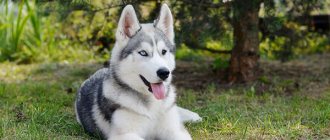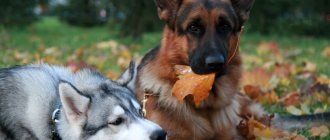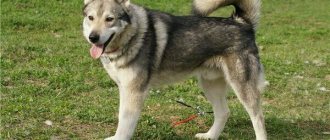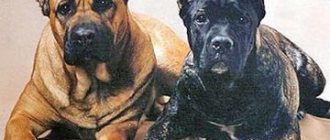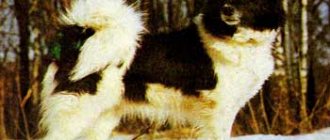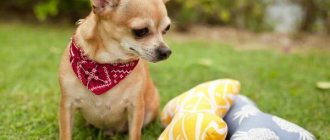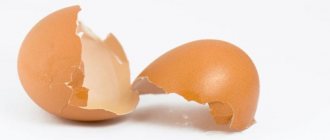Many people who are not very well versed in dog breeding confuse huskies and huskies and do not know what the difference is between them.
Indeed, there are many similarities between these two breeds, however, they have no less differences.
Moreover, this applies not only to the exterior, but also to the characteristics of the psyche, character, temperament and even purpose.
All this must be taken into account when keeping, raising and training these dogs, and therefore, anyone who is thinking about purchasing a husky or husky needs to study the similarities and differences of these two dogs before purchasing a puppy.
This will not only help provide the pet with the most suitable living conditions, but will also save their owners from disappointment in the future.
Brief information about Husky
Photo and description
The dog is of medium height (approximately from 50 to 60 cm at the withers, weight is about 15-28 kg), compact, but at the same time harmonious build.
The body is slightly stretched and exceeds the height at the withers by no more than 2-3 cm; the shape of the head from above resembles a triangle, slightly tapering towards the muzzle. The stop is well defined, but not sharp.
The length of the muzzle is approximately equal to the length of the cranial part of the head.
The ears are erect, triangular, of medium size, set quite close to each other.
The eyes are almond-shaped, slightly slanted. Their color can be blue, brown, amber, olive. In addition, different eye colors .
IMPORTANT!
The nose, as well as the pigmentation of the lips and rims of the eyelids, depending on the color, can be black or brownish.
The neck is of medium length, the chest is deep and powerful, but not too voluminous. The forelimbs are moderately wide, even and parallel. The hind legs are muscular, with well-defined angulations of the hock joints. The tail is similar to a fox's, in a calm state it is lowered downwards, but when alert, it is carried in the form of a sickle over the back.
The coat is not too long, two-layered, while the undercoat is thick and soft, and the coarser hair is quite smooth and adjacent to the body. The color can be almost any, although the most typical colors for huskies are grey-white, black-and-white, brown-white and reddish-white.
Advantages and disadvantages
Pros:
- Intelligence and intelligence.
- Ability to make decisions independently when necessary.
- Lack of aggression towards humans.
- Love for children and playful disposition.
- Loyalty to the owner.
- Endurance and unpretentiousness.
- Easy hair care.
- They make excellent sled or sport dogs.
Minuses:
- Not suitable as guard dogs.
- Tendency to dig up the earth.
- Sometimes they are headstrong and stubborn.
- They often howl.
- They can be aggressive towards smaller animals.
- They need a lot of physical activity and long walks.
- Out of boredom, they can start to damage things in the house.
Character
Lively and friendly towards people. Huskies, unless serious mistakes were made during their upbringing , are never aggressive towards humans and are not inclined to bite.
Friendliness towards strangers and lack of territorial instinct make these dogs poor guards and this must be taken into account by people thinking about purchasing such a pet.
Huskies have an innate hunting instinct, but they will not make hunters either. These dogs hunt for game only for their own food and will never give it up to their owner of their own free will.
These are independent, independent, and sometimes stubborn and willful animals, prone to running away and wandering.
In addition, huskies love to dig up the ground and, out of boredom, can chew furniture, tear off wallpaper, or howl like wolves.
However, when keeping these dogs in the house, you need to take into account that most of the bad habits of a husky are easy to remove or simply prevent them from appearing in your pet. This is achieved through early socialization and proper education and training.
In addition, as noted above, huskies act out mainly from boredom and idleness, and therefore, if you provide the dog with sufficient mental and physical stress, it simply will not have time for mischief.
A little about likes
Photo and description
Laikas are not representatives of one breed, but a breed group that unites several dogs similar in origin, appearance and purpose.
Most huskies are hunting dogs, although many are also suitable for other work. For example, the Nenets Laika is excellent at herding deer, and the Yakut Laika can be used not only for hunting, but also as a sled dog.
In terms of their physique and coat characteristics, huskies are very close to dogs of the so-called wild or wolf type. Moreover, representatives of different breeds of huskies differ from each other, first of all, in the structure of the head and muzzle.
All of them are characterized by a strong, but not squat, build, as well as pointed, erect ears and a tail curled into a full or incomplete ring.
The coat of these dogs is not too long, but at the same time very dense and thick, with an abundant, moderately soft undercoat.
Laikas can come in a variety of colors, but the most typical coat colors are wolf, gray or black, often accompanied by white markings of various shapes and sizes.
Advantages and disadvantages
Pros:
- Excellent hunting dogs, suitable for tracking a variety of game.
- Hardy and unpretentious.
- They are distinguished by good health and, often, long life expectancy.
- Balanced and calm character.
- Devotion and obedience.
- Goodwill towards people, which, however, does not prevent huskies from being good guards.
- Undemanding to nutrition.
Minuses:
- Not suitable for keeping in an apartment.
- Hunting huskies may be at risk of contracting a serious infection in the forest or field.
- Very strong shedding.
- Despite their devotion, they can become disobedient when chasing game.
Character
Laika is quite independent and proud; she recognizes only partnerships with her owner and does not tolerate either excessive familiarity or rudeness in handling herself. This is a very smart and quick-witted animal, which, depending on the current situation, can make its own decisions during the hunt.
Laikas are friendly towards people and make good companions for children, especially since most of these dogs have a cheerful and playful disposition. Laikas are distrustful of strangers, but without increased aggression.
NOTE!
These dogs have an innate viciousness and ruthlessness towards prey, therefore, huskies need early socialization, without which they can be dangerous to pets smaller than themselves.
Choosing a puppy
Yakut Laika breed kittens are charming creatures that will not leave anyone indifferent.
Everyone will want to buy these fluffy blue-eyed little lumps.
Selection rules:
- It is not advisable to purchase dogs on the market, to eliminate the possibility of purchasing unhealthy and not purebred individuals.
- You need to pick up the puppy when it reaches the age of 8-10 weeks. Before doing this, you need to check all the accompanying documents (passport, vaccination card, etc.). The cutlets should not be too fat, but not too thin either.
- If possible, find out how the dogs were kept in the kennel. Collect information about the parents, and also ask how the mother of the puppies treated them and how much she fed them.
- Before purchasing a pet, you must prepare a spacious enclosure for it. For puppies, it is recommended to install a house inside the enclosure for proper rest and privacy from view.
Laika should not be kept in an enclosure all the time. She needs freedom and long walks in the fresh air.
Dogs of the Yakut Laika breed combine incompatible qualities. They are hardy, strong, excellent hunters and at the same time balanced and loyal.
For a long time, these pets have been valuable helpers for people.
In any case, each dog is individual, and therefore may differ in appearance from the standard description.
Main differences
The main characteristics by which huskies and huskies differ:
- Huskies have a denser and more muscular build, while huskies are taller and have lighter bones.
- Huskies' ears are rounded at the ends, while huskies' ears are pointed.
- Husky paws are wider, stronger and more powerful than those of huskies.
- Laikas have rounder eyes, while Huskies have almond-shaped eyes. In addition, the eye color of a husky can only be dark, and not blue or heterochromic, like that of a husky.
- The look of a husky expresses curiosity and energy, while the look of huskies shows balance, attentiveness and some wariness.
- The fur of huskies is coarser in texture than that of huskies.
- The husky's tail is held downwards or in the shape of a sickle, while in huskies it is curled into a complete or incomplete ring.
- Huskies are larger in size: their height reaches 60 cm and their weight is 28 kg, while huskies are smaller and weigh more than 23 kg.
Huskies are larger and heavier than huskies, they have stronger bones and better developed muscles. Laikas look taller and lighter-boned compared to them.
Husky ears are rounded at the ends, while husky ears are sharper, and eyes can be not only brown, but also blue and even different colors. Laikas can be exceptionally dark-eyed, and their gaze is calmer and more serious than that of a husky.
The main external difference between the husky and the husky is that the husky’s tail is wrapped in a ring, while the husky’s tail resembles a fox’s and hangs down when at rest.
Breeding history
The origin of the Yakut Laika and the description of the breed go far back into history. It is known that such domesticated dogs helped ancient people in everyday life. Thanks to their excellent sense of smell, they saved more than one lost person.
In addition, having excellent eyesight and hearing, huskies helped people hunt. Long before the advent of snowmobiles, dogs were used for sledding to transport goods.
Laika breeding began only in the late 90s. And already in 2005, cynologists in Russia approved the breed standard, and dogs began to participate in exhibitions and competitions.
In 2008, the first show of the breed was organized, as a result of which the owners of blue transparent eyes received a lot of fans and connoisseurs.
Common features
The main external similarity of these dogs is their erect ears, as well as a wedge-shaped head and a slightly pointed muzzle.
The coat of a husky and a husky also has a similar structure - it is very dense and dense, consisting of a soft undercoat and a coarser and tougher awn.
Both huskies and huskies look like strong and hardy animals, and they also both have some external resemblance to wolves.
Features of breeds
Despite the strong external similarity, these pets belong to different groups. The Laika is a dog breed that includes 4 different species. Her work activities are extensive, from hunting to moving a team. Thanks to this, such a dog develops appropriate external characteristics.
This is interesting: Features of the Karelian-Finnish Laika
Types of huskies recognized by the FCI standard:
- West Siberian;
- Russian-European;
- Karelian-Finnish;
- East Siberian.
Husky is an independent breed approved by canine associations around the world. Dogs were bred to move heavy sleds over long distances. The husky differs from the husky in its outstanding physical strength and endurance. It is able to withstand heavy loads for a long time. Despite their external resemblance to a wolf, these dogs do not hunt and do not protect their owner. Aggressive representatives of the breed were specifically excluded from breeding.
This is interesting: What determines life expectancy
Types of Husky:
- Alaskan;
- Siberian;
- Sakhalin
The Siberian husky variety is constantly confused with the husky.
Who is easier to maintain and care for?
Despite the popular belief that Huskies are not easy to keep indoors, caring for these dogs is not difficult. Representatives of this breed require infrequent brushing, occasional bathing as needed, and eye, ear, and nail care. Only during shedding do they need to be brushed daily.
In huskies, shedding is more pronounced than even in huskies, which makes caring for them somewhat more difficult. In addition, these dogs' fur has a coarser texture, making it more difficult to remove from clothing, carpets and upholstered furniture.
IMPORTANT!
When caring for and maintaining hunting huskies, you should never neglect treating your pet for parasites and timely vaccinations, since these dogs are prone to infectious diseases transmitted from other animals or carried by external parasites.
Possible diseases
Of course, any animal must be vaccinated on time. Regarding vaccinations, there is a separate article on our website dedicated to this issue, we recommend that you read it. In general, huskies bred in extreme cold conditions have strong immunity, but these pets can also get sick.
Representatives of this species are characterized by the following diseases:
- eczema;
- nasal pigmentation;
- stomach cancer (always watch your diet);
- retinal atrophy and other eye diseases;
- hip dysplasia.
Attitude towards children and pets
Both huskies and many huskies have a cheerful and playful disposition and are good with children.
However, some breeds of huskies are not recommended as pets for families with children, as their nature is too stern and independent for these dogs to calmly deal with children who bother them or tease them.
As for the attitude of these dogs towards other domestic animals, huskies, who do not have innate malice towards the beast, are more tolerant of them than huskies.
Optimal diet
Both adult dogs and puppies should eat a nutritious and balanced diet in order to receive all the substances necessary for healthy development. Dog handlers advise giving huskies only high-quality food.
If your pet is fed homemade products, the diet should be prepared very carefully.
Puppy
Everything in a puppy’s nutrition must be thought out to the smallest detail if you want the dog to grow up beautiful and healthy.
The diet of a little husky must contain the following products:
- Raw and boiled meat. It can be either game, rabbit or beef. Since this is the main component, it should be included in the puppy's menu every day.
- Fish, preferably sea fish, the main thing is less bones so that the pet does not choke. It contains a lot of useful substances that are so necessary for a growing body. It is enough to give fish a couple of days a week.
- Dairy products. They are essential for the proper formation of animal bones. They are included in the huskies menu several times a week. It can be cottage cheese, kefir, milk.
- Eggs. They are given raw 4-5 times a month.
- Vegetables. Boiled or fried, seasoned with oil.
- Fruits.
Did you know? There are about 700 varieties of dog breeds in nature.
Very young puppies need to be fed 5-6 times a day. From 6 months of age, the number of feedings is reduced to 3–4.
Water should be in the animal's drinking bowl at all times.
Adult dog
It is enough to feed an adult dog 2 times a day.
Homemade food can go well with feed. But feed should be selected only of high quality so that it is well digested.
The diet of an adult husky is not very different in composition from the menu of puppies. For full development, the diet must also contain meat, vegetables, cottage cheese, and fish.
It is better to exclude the following components from the diet:
- potato;
- pork meat;
- candies, sweets, cakes;
- peas;
- smoked meats
These foods may be difficult for the stomach of huskies to digest.
Who is more picky about feeding?
Both dogs can eat both home-cooked and commercially prepared food and are not particularly picky about what they feed.
However, you need to take into account that huskies are more prone to overeating, and therefore it is necessary to take a more responsible approach to their diet and not supplement the pet between feedings.
Comparison by other criteria
Aggression towards people
Uncharacteristic of either huskies or huskies.
But at the same time, the latter can treat strangers with distrust and can even be good guards, while huskies are friendly towards all people and because of this are completely unsuitable for protection.
Activity and exercise
Both dogs require a lot of exercise and are energetic and active. There are almost no differences in this matter.
Lifespan
The difference here is that huskies live on average 12-14 years, while the life expectancy of huskies can reach 17 years.
Photo gallery
Interesting photos are in this section.
Photo 1. Two spotted huskies
Photo 2. Yakut Laika puppy
Photo 3. Snow-white husky
Price difference
The cost of husky puppies with documents starts from 15 thousand.
A small husky can be purchased for 5-10 thousand, however, if we are talking about purchasing a dog from parents who have shown excellent results in hunting, then its cost may be slightly higher.
Who should you choose?
When choosing who to buy, you must, first of all, proceed from the purpose of the future pet. If you need a hunting dog, then you need to buy a husky, but if you need a dog for sledding, then you should buy a husky.
Conditions of detention are also of great importance. Laikas are not suitable for living in an apartment, while huskies tolerate indoor living quite well, provided they receive sufficient physical and mental exercise.
NOTE!
For families with small children, a husky is better suited, since not all huskies can be kind to kids, but at the same time they will make wonderful friends for older children.
